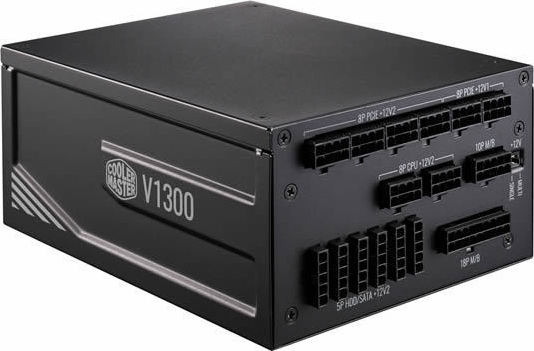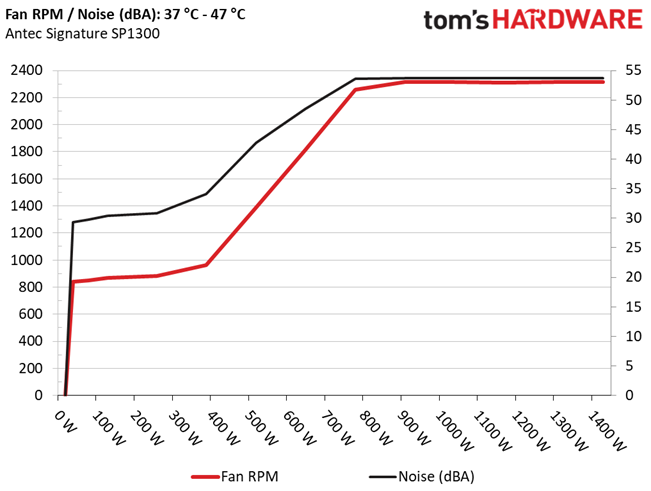Why you can trust Tom's Hardware
To learn more about our PSU tests and methodology, please check out How We Test Power Supply Units.
Primary Rails And 5VSB Load Regulation
The following charts show the main rails' voltage values recorded between a range of 40W up to the PSU's maximum specified load, along with the deviation (in percent). Tight regulation is an important consideration every time we review a power supply because it facilitates constant voltage levels despite varying loads. Tight load regulation also, among other factors, improves the system’s stability, especially under overclocked conditions and, at the same time, it applies less stress to the DC-DC converters that many system components utilize.
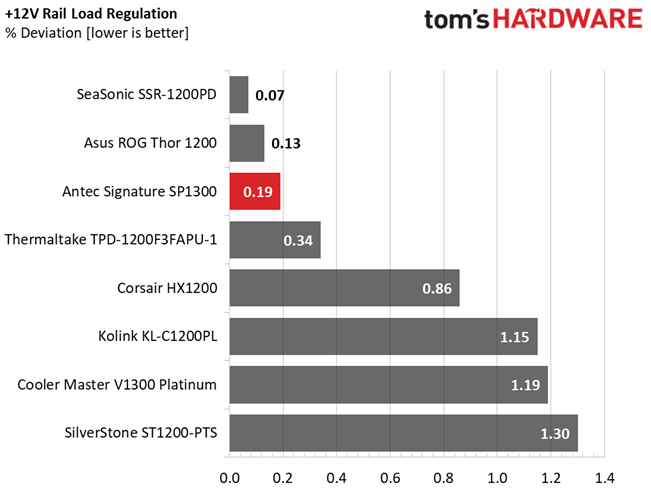
Results 1-8: Load Regulation






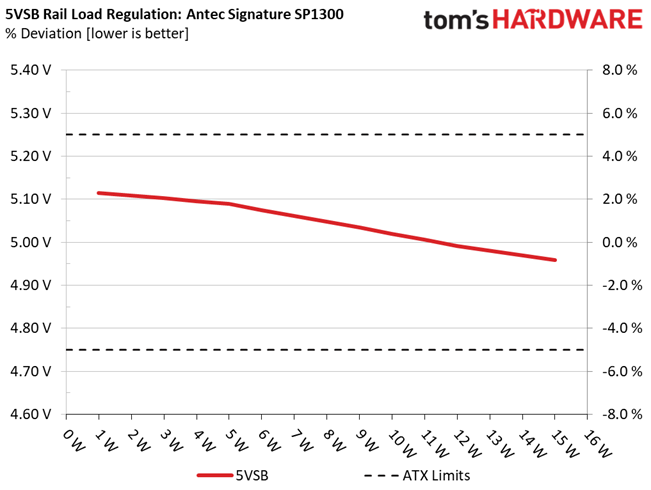
The load regulation is tight on all rails but 5VSB, where it doesn't play a significant role, from the moment the voltage in this rail is within spec.
Hold-Up Time
Put simply; hold-up time is the amount of time that the system can continue to run without shutting down or rebooting during a power interruption.

Results 9-12: Hold-Up Time






The hold-up reaches 21ms and the power ok signal is accurate.
Inrush Current
Inrush current, or switch-on surge, refers to the maximum, instantaneous input current drawn by an electrical device when it is first turned on. A large enough inrush current can cause circuit breakers and fuses to trip. It can also damage switches, relays, and bridge rectifiers. As a result, the lower the inrush current of a PSU right as it is turned on, the better.

Results 13-14: Inrush Current

The inrush current is low, with both voltage inputs. The NTC thermistor-relay combo does a fantastic job.
Get Tom's Hardware's best news and in-depth reviews, straight to your inbox.
10-110% Load Tests
These tests reveal the SP1300's load regulation and efficiency levels under high ambient temperatures. They also show how the fan speed profile behaves under increased operating temperatures.
| Test # | 12V | 5V | 3.3V | 5VSB | DC/AC (Watts) | Efficiency | Fan Speed (RPM) | PSU Noise (dB[A]) | Temps (In/Out) | PF/AC Volts |
| 1 | 8.804A | 1.955A | 1.964A | 0.982A | 129.982 | 87.170% | 867 | 30.4 | 40.86°C | 0.985 |
| 12.311V | 5.113V | 3.362V | 5.089V | 149.114 | 45.01°C | 115.16V | ||||
| 2 | 18.613A | 2.936A | 2.947A | 1.182A | 260.008 | 90.917% | 882 | 30.8 | 41.41°C | 0.985 |
| 12.309V | 5.110V | 3.359V | 5.075V | 285.983 | 46.11°C | 115.15V | ||||
| 3 | 28.723A | 3.427A | 3.440A | 1.383A | 389.515 | 91.844% | 965 | 34.1 | 41.51°C | 0.991 |
| 12.306V | 5.107V | 3.357V | 5.061V | 424.106 | 46.47°C | 115.15V | ||||
| 4 | 38.877A | 3.920A | 3.934A | 1.585A | 519.511 | 91.915% | 1386 | 42.8 | 41.82°C | 0.994 |
| 12.303V | 5.104V | 3.355V | 5.048V | 565.206 | 47.82°C | 115.14V | ||||
| 5 | 48.709A | 4.902A | 4.924A | 1.788A | 649.632 | 91.549% | 1814 | 48.5 | 42.29°C | 0.996 |
| 12.300V | 5.101V | 3.352V | 5.034V | 709.604 | 48.77°C | 115.13V | ||||
| 6 | 58.550A | 5.886A | 5.912A | 1.992A | 779.796 | 90.895% | 2259 | 53.6 | 42.85°C | 0.997 |
| 12.297V | 5.098V | 3.349V | 5.020V | 857.911 | 49.81°C | 115.13V | ||||
| 7 | 68.384A | 6.872A | 6.903A | 2.196A | 909.892 | 90.392% | 2315 | 53.7 | 43.85°C | 0.998 |
| 12.295V | 5.095V | 3.347V | 5.006V | 1006.608 | 51.32°C | 115.11V | ||||
| 8 | 78.231A | 7.859A | 7.894A | 2.403A | 1040.027 | 89.765% | 2314 | 53.7 | 43.92°C | 0.998 |
| 12.292V | 5.092V | 3.344V | 4.992V | 1158.616 | 52.15°C | 115.11V | ||||
| 9 | 88.460A | 8.354A | 8.378A | 2.407A | 1169.763 | 89.031% | 2311 | 53.7 | 44.28°C | 0.998 |
| 12.291V | 5.089V | 3.341V | 4.984V | 1313.890 | 53.17°C | 115.10V | ||||
| 10 | 98.468A | 8.850A | 8.894A | 3.024A | 1299.777 | 88.083% | 2313 | 53.7 | 45.86°C | 0.998 |
| 12.289V | 5.086V | 3.339V | 4.959V | 1475.626 | 55.19°C | 115.09V | ||||
| 11 | 109.069A | 8.854A | 8.897A | 3.029A | 1429.819 | 86.989% | 2315 | 53.7 | 46.89°C | 0.998 |
| 12.287V | 5.083V | 3.337V | 4.950V | 1643.680 | 56.81°C | 115.08V | ||||
| CL1 | 0.100A | 15.001A | 14.997A | 0.000A | 128.081 | 82.077% | 2290 | 53.7 | 42.80°C | 0.987 |
| 12.318V | 5.104V | 3.353V | 5.103V | 156.049 | 49.31°C | 115.17V | ||||
| CL2 | 108.016A | 1.000A | 0.999A | 1.000A | 1340.532 | 88.128% | 2307 | 53.7 | 46.07°C | 0.998 |
| 12.286V | 5.092V | 3.345V | 5.013V | 1521.123 | 56.49°C | 115.09V |
The SP1300 doesn't have a problem under high operating temperatures, but most likely, you won't be able to tolerate the increased noise output, with its fan spinning at 2300RPM. The compact PCB doesn't allow for optimal airflow since it is overloaded with the parts required for >1300W output, so the fan has to work over hours. Still, given the platform's high efficiency, the fan speed profile could be more relaxed.
20-80W Load Tests
In the following tests, we measure the SP1300's efficiency at loads significantly lower than 10% of its maximum capacity (the lowest load the 80 PLUS standard measures). This is important for representing when a PC is idle with power-saving features turned on.
| Test # | 12V | 5V | 3.3V | 5VSB | DC/AC (Watts) | Efficiency | Fan Speed (RPM) | PSU Noise (dB[A]) | PF/AC Volts |
| 1 | 1.204A | 0.489A | 0.489A | 0.196A | 19.977 | 62.961% | 0 | <6.0 | 0.851 |
| 12.311V | 5.122V | 3.369V | 5.115V | 31.729 | 115.14V | ||||
| 2 | 2.410A | 0.978A | 0.980A | 0.391A | 39.970 | 74.432% | 840 | 29.3 | 0.927 |
| 12.311V | 5.117V | 3.365V | 5.109V | 53.700 | 115.16V | ||||
| 3 | 3.619A | 1.467A | 1.470A | 0.588A | 60.002 | 79.651% | 843 | 29.5 | 0.952 |
| 12.311V | 5.115V | 3.364V | 5.102V | 75.331 | 115.16V | ||||
| 4 | 4.822A | 1.953A | 1.962A | 0.785A | 79.955 | 83.337% | 851 | 29.8 | 0.971 |
| 12.312V | 5.114V | 3.363V | 5.096V | 95.942 | 115.16V |
Even at light loads, but with more than 35 degrees Celsius ambient, the fan's noise is increased.
2% or 10W Load Test
Intel plans on raising the ante at efficiency levels under ultra-light loads. So from July 2020, the ATX spec requires 70% and higher efficiency with 115V input. The applied load is only 10W for PSUs with 500W and lower capacities, while for stronger units we dial 2% of their max-rated-capacity.
| Test # | 12V | 5V | 3.3V | 5VSB | DC/AC (Watts) | Efficiency | Fan Speed (RPM) | PSU Noise (dB[A]) | PF/AC Volts |
| 1 | 1.952A | 0.273A | 0.273A | 0.054A | 26.619 | 68.147% | 0 | <6.0 | 0.887 |
| 12.308V | 5.121V | 3.368V | 5.117V | 39.061 | 115.19V |
Although it cannot reach the 70% threshold that the newest ATX spec (2.52) requires, it is still impressive to see a 1300W PSU achieving so high efficiency with 2% of its max-rated-capacity load.
Efficiency
Next, we plotted a chart showing the SP1300's efficiency at low loads, and loads from 10 to 110% of its maximum-rated capacity. The higher a PSU’s efficiency, the less energy goes wasted, leading to a reduced carbon footprint and lower electricity bills.

Results 15-18: Efficiency



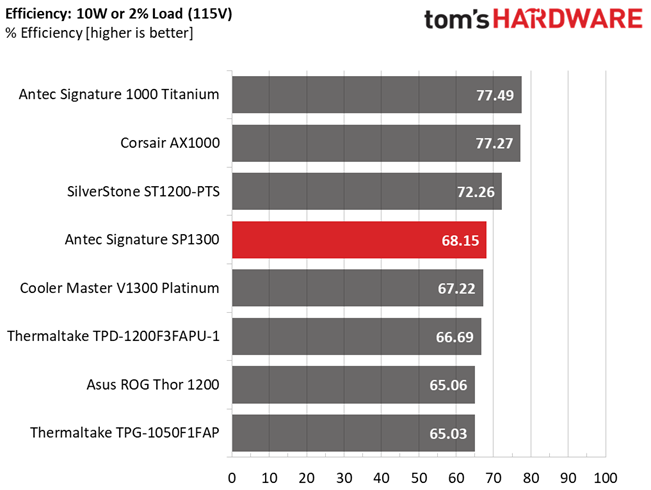
The efficiency levels are satisfactory in all load ranges.
5VSB Efficiency
| Test # | 5VSB | DC/AC (Watts) | Efficiency | PF/AC Volts |
| 1 | 0.100A | 0.512 | 73.669% | 0.071 |
| 5.118V | 0.695 | 115.16V | ||
| 2 | 0.250A | 1.278 | 78.405% | 0.155 |
| 5.114V | 1.630 | 115.16V | ||
| 3 | 0.550A | 2.809 | 80.533% | 0.269 |
| 5.107V | 3.488 | 115.16V | ||
| 4 | 1.000A | 5.096 | 80.646% | 0.362 |
| 5.097V | 6.319 | 115.16V | ||
| 5 | 1.500A | 7.626 | 80.265% | 0.415 |
| 5.084V | 9.501 | 115.16V | ||
| 6 | 2.999A | 15.143 | 79.059% | 0.487 |
| 5.049V | 19.154 | 115.16V |

Results 19-20: 5VSB Efficiency
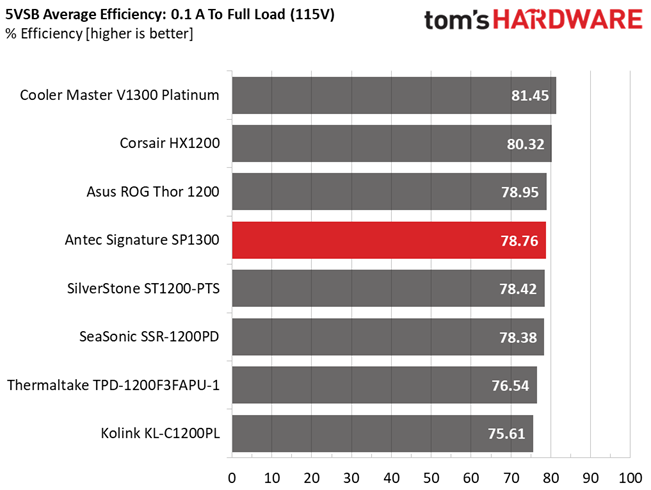
It is nice to see an efficient 5VSB rail.
Power Consumption In Idle And Standby
| Mode | 12V | 5V | 3.3V | 5VSB | Watts | PF/AC Volts |
| Idle | 12.305V | 5.123V | 3.369V | 5.121V | 11.445 | 0.573 |
| 115.2V | ||||||
| Standby | 0.057 | 0.006 | ||||
| 115.2V |

Results 21-22: Vampire Power

The phantom power levels are low, with both voltage inputs.
Fan RPM, Delta Temperature, And Output Noise
All results are obtained between an ambient temperature of 37 to 47 degrees Celsius (98.6 to 116.6 degrees Fahrenheit).
The fan profile is aggressive. This is expected, to a degree, at least, given the compact dimensions and the high power levels that this platform can deliver.
The following results were obtained at 30 to 32 degrees Celsius (86 to 89.6 degrees Fahrenheit) ambient temperature.
Up to 450W, the PSU's noise is kept low, but with higher loads (especially >820W) things change, dramatically.
MORE: Best Power Supplies
MORE: How We Test Power Supplies
MORE: All Power Supply Content
Current page: Load Regulation, Hold-Up Time, Inrush Current, Efficiency and Noise
Prev Page Specifications and Part Analysis Next Page Protection Features, DC Power Sequencing, Cross-Load Tests and Infrared Images
Aris Mpitziopoulos is a contributing editor at Tom's Hardware, covering PSUs.


